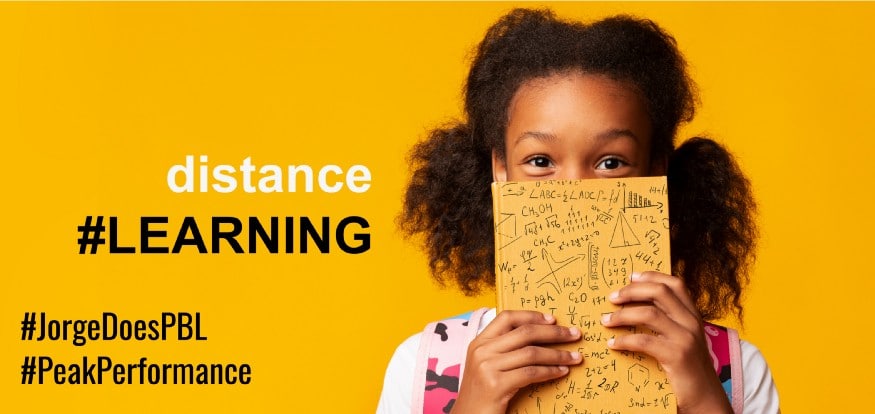September 2, 2020
Jorge Valenzuela provides a series of useful tips and information for remote teaching.

Like many teachers at this time, the COVID-19 crisis caused me to deliver all my lessons through remore teaching. Although, I was not new to online teaching or coaching — I wasn’t sure how the experience would be fun or engaging for either myself or my learners who were now being forced to assimilate.
I knew the basics to deliver content online — or at least I thought I did! But knowing the basics is what initially had me very worried for many of my students. How can learners who were accustomed to receiving my instruction through systematic and reflective practices (i.e., evidence-based instructional strategies and educational protocols) now get the same level of engagement through Zoom and my PowerPoint slides? And for how long should our lessons and meeting times be held?
Now that the entire education community has rallied to provide their resources and talents at no charge to educators — I have begun using edtech tools that have the power to engage learners who require my digital instruction to be interactive and personalized.
For my teaching to be optimal, I require edtech with video with breakout capabilities, dynamic slides, and to be social enough for my most connected students. After toying with several options — I settled on my top three must-haves for leveling up my online teaching and here’s how you can as well.
RECOMMENDED: https://global-edtech.com/category/community/
Use virtual breakout rooms to enhance student collaboration
Having my students pair up during activities or work in project teams is an integral component of my instruction that I didn’t want to lose at this time. Fortunately, the Zoom platform enables online facilitators to place student project teams in breakout rooms for collaboration.
Some examples of how I blend my teaching strategies with the Zoom breakout room virtual feature include:
– Storytelling at the beginning of a mini-lesson: To inspire students and connect their previous knowledge to new concepts, I like to share related stories. The students then go into breakout rooms (either in pairs or triads) to share their own stories. This shouldn’t take more than five minutes.
– Turn and talk: I use this as an informal and low-stakes way for students to share their thoughts and ideas. Students are paired and only go into breakout rooms for about 3–5 minutes.
– Jigsaws: Groups of 3–4 students spend time in breakout rooms reading, developing computational artifacts and debriefing. Work time varies between projects and it is important for teachers to make frequent check-ins.
– Work time in projects: The meaning of work time varies between guided and independent practice. For this purpose, I love to form learning centers in the breakout rooms within the structure of the workshop model.
– Feedback protocols: The number of students assigned per breakout room will vary depending on the protocol you use. Prior to using a protocol, be sure to model its use for the entire class before sending them into the breakout rooms. Also, be sure to be the timekeeper and use the broadcast feature to keep everyone on task during the protocols.
Some examples of how teachers can blend effective remote teaching strategies with breakout rooms in Zoom for English language learners:
– Making group work relevant by allowing students to choose topics that matter to their specific community (i.e., Latinx).
– Allowing voice and choice about the type of products students create to demonstrate learning.
– Providing small group instruction with an emphasis on language skills across the content areas.
– Using visuals for encouraging dialogue and comprehension.
– Use their native language as a support for learning English.
– Having them practice with sentence starters.
My students really enjoy being able to collaborate virtually during class time using Zoom. I love that that the breakout feature also allows me to visit each of their spaces — which enables me to personalize my ability to engage and coach and also clarify misunderstandings about the material being taught.
Other remote teaching platforms with the breakout feature include GoToMeeting, Microsoft Teams, and RingCentral. But before diving in — it is important that educators connect with students ONLY via platforms that are supported by their school district.
Use interactive and dynamic slides
When the pandemic arrived, I was very concerned with my ability to keep students engaged and collaborative virtually with ONLY my traditional PowerPoint slides. When teaching in person, I always teach using systematic and reflective strategies — and because ONLY my academic class content changes — my classes have developed norms and collaborative culture with an inquiry mindset. And I was not sure how I was going to make this happen digitally.
Luckily, Nearpod success manager and expert user Michelle Moore — introduced me to the tool and gave me the quick skinny. The Nearpod platform is designed for student engagement during lessons, and what immediately enticed me was the ability to upload my existing slide decks and then tweak them to add the interactive features I desired for lessons/projects using the ‘add activity.’
Incorporating slides using the ‘add activity’ feature in Nearpod has enabled student participation during my lessons in ways I never thought possible AND best of all — in real-time! I have found that adding polls, fill in the blank activities, short quizzes, open-ended questions, and drawing (among other items) allows my students to be better vested during our time together because our lessons are now a dialogue that isn’t one-sided.
Another added bonus is that Nearpod has partnered with ISTE to develop digital teaching content for ISTE members to access for free. And a lot of this content can be added seamlessly into either my existing or new lessons.
Other online presentation slide alternatives for teachers to consider for remote teaching include Knovio, Google Slides, and Keynote.
Keep students social — even in class
Let’s face it; many of our students are using various social media platforms to connect with others socially by creating content (i.e., videos and pictures) on a daily basis. Finding a tool to leverage this aspect of their lives and personalities can be challenging but if it means helping my learners connect with others academically — I think it’s worth the exploration.
Ofcom of the UK reports that the older kids get, the more active they’re likely to use social media. CNN reports similar findings from studies indicating that many US teens use devices more than seven hours a day and that the median age of first use of social media is 14.
For engaging students socially in their new virtual classroom projects/lessons at this time of crisis, many in my PLN have begun using Flipgrid for free! I like that Flipgrid allows teachers to create grids by academic topics and are a safe space for learners to record and showcase their short videos. This is a feature that is now being leveraged by some educators to lift each of the diverse voices in their digital classrooms. Flipgrid topics can also be embedded in a Nearpod lesson!
For getting started and answering my ‘need to knows’, I found the Flipgrid Educator’s Guide to be an excellent resource. I was able to incorporate Flipgrid into some of my lesson activities in tandem with Nearpod and Zoom and find the app useful for establishing community, having students respond to class topics, reflections on learning, and bringing in experts in ‘topic guest’ mode.
Another useful app for keeping kids engaged in comparable ways to how they interact socially with others is Recap. The app is also free to educators and enables student responses via video but also through text and audio.
It’s up to us
No doubt, the current crisis has changed many aspects of how we live, work and do school. I believe the same holds true for our teaching pedagogy — it needs to evolve. Our students are accustomed to a world of their own design. To teach them, I believe we will need to meet them halfway strategically. With both the availability and the capabilities of today’s technology — it’s on us to prepare ourselves with engaging lessons and embrace remote teaching.
This article is an extension of a article previously published by Jorge here: https://www.iste.org/explore/learning-during-covid-19-2










0 Comments